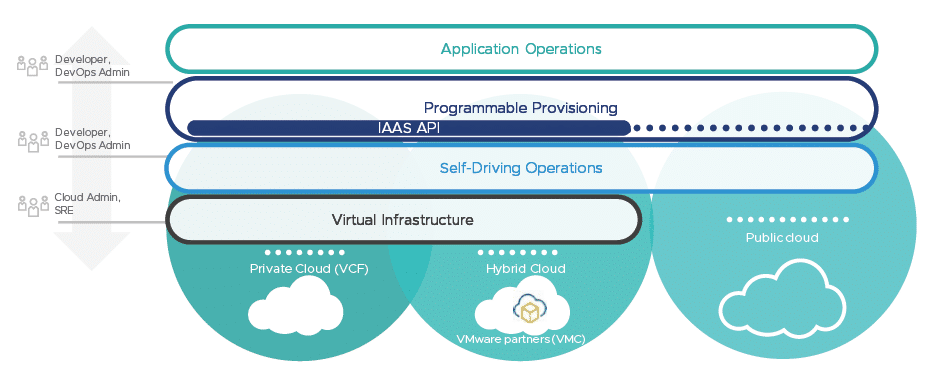Today at VMworld 2018 in Las Vegas, VMware Inc. announced that it was making additions and enhancements to its Cloud Operations Services to tackle the issues of multi-cloud environments head on. According to the company these new services will enable cloud operations, DevOps, and security and compliance teams to better manage cloud costs, operations, security, and compliance across clouds. The enhancements announced today include new cloud automation services, VMware Cloud Assembly, VMware Service Broker, and VMware Code Stream; a new cloud configuration security and compliance service, VMware Secure State; and significant enhancements to Wavefront by VMware.

Multi-cloud environments are not an emerging trend, they are here. As organizations find ways to store and analyze their data they need to leverage different public cloud options. This is one way to meet the needs but it presents issues of its own, mainly disparate tools and an overall lack of visibility into one's own data. To help assuage some of the fears of multi-cloud VMware has rolled out its Cloud Services that help to unify the experience for Cloud Engineering and Operations teams. These services give users visibility into their cloud resources that in turn helps them to manage costs, increase efficiencies such as resource utilization, and can help them gain insights.
One of the quickest ways to improve efficiencies is to automate mundane tasks. VMware is rolling out new automation services that promise to ease and speed up the development and deployment of applications. Consisting of VMware Cloud Assembly, VMware Service Broker and VMware Code Stream, these automation services can not only make it easier to create and deploy applications but also can enable cloud flexibility and choice, and control risks. Benefits and features include:
- VMware Cloud Assembly: Developers want the same experience of automating deployment and consumption of infrastructure and applications in private and hybrid clouds as they get with public clouds. Cloud Assembly delivers unified provisioning across all clouds through declarative Infrastructure as Code, including VMware Cloud on AWS, native AWS and Azure. With Cloud Assembly, IT and cloud operations teams can orchestrate and expedite infrastructure and application delivery in line with DevOps principles, improving the overall developer experience, Developers get an experience equivalent to provisioning resources from native public clouds.
- VMware Service Broker: Service Broker provides simple, self-service access to multi-cloud infrastructure and application resources from a single catalog, without requiring disparate tools. With Service Broker, operations teams can more effectively govern resource access and use and enforce security, deployment and business policies across multi-cloud environments.
- VMware Code Stream: Enterprise development teams are creating and iterating on applications faster than ever, but this work is often delivered using a combination of manual scripting and a mix of delivery tools. This creates challenges with delivery speed, visibility and troubleshooting for code releases. Code Stream automates the code and application release process with a comprehensive set of capabilities for application deployment, testing, and troubleshooting. It features integrations with popular developer tools and supports VMware-based private clouds, VMware Cloud on AWS, and AWS and Azure public clouds. With Code Stream, enterprises get code and applications out faster, and reduce the time it takes to correct issues when they arise.
One of the earlier concerns, and criticisms, of the public cloud was security. While they have come a long way in the last few years, security is still something that has to remain a top priority. On this front VMware has its Secure State that it states addresses violations in cloud configurations in real time by automating configuration security and compliance monitoring in native cloud environments. This service can keep security breaches from happening, which not only save time and money, but retains customer confidence. VMware Secure State provides:
- Security Insights: Indexes cloud assets and builds a cloud infrastructure model to efficiently find common cloud-native vulnerabilities, as well as an emerging class of “connected threats” across configured cloud service layers. Provides contextual information and a “threat chain” for objects with associated cloud object relationships.
- Real-Time Detection: Tracks all changes to the cloud infrastructure in real-time, providing fast notifications for object changes and the related services that may be affected. VMware Secure State proactively scales configuration security insights across security, cloud engineering, and DevOps teams.
- Continuous Compliance: Includes out of the box compliance monitoring and reporting to provide overarching and targeted on-demand compliance benchmark reporting.
The final area where VMware is tackling for multi-cloud environments is with monitoring and analytics. Wavefront is the company's cloud-native monitoring and analytics platform that VMware claims can give instant insight into performance of highly distributed, web-scale applications. New updates and enhancements include:
- Massive container scalability: Based on internal testing, VMware has validated that Wavefront can ingest, analyze, and visualize metrics data from an environment running 100,000 containers.
- Comprehensive Kubernetes Support: Wavefront provides holistic Kubernetes metrics insight to help ensure no monitoring blind spots. Building on the integration with Pivotal Container Service (PKS), Wavefront has added quick start from within PKS; programmatic enforcement of pre-defined alerts for important KPIs across desired Kubernetes clusters and components; and kube-state metrics to gain a holistic understanding of the health of Kubernetes within PKS.
- Serverless Application Monitoring: New Lambda SDK and dashboards enable developers to deliver serverless code with greater speed, accuracy and reliability. Delta Counters, a new metric type, delivers more accurate reporting.
- New Visualizations and AWS UX Enhancements: New features provide real-time visibility into applications using public cloud, containerized, and microservices topologies. Wavefront’s new AWS dashboards accelerate incident resolution time by quickly visualizing where an incident is happening and seamlessly drilling down to the asset of suspected cause. New metric visualization widgets help identify anomalies and incident causes faster.
Availability
The new capabilities for Wavefront by VMware are generally available. VMware Cloud Assembly, VMware Service Broker, and VMware Code Stream are initially available today. VMware Secure State is currently in public beta.




 Amazon
Amazon